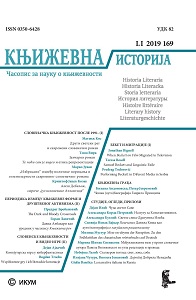Светле слике Драгутина Илића
Dragutin Ilić’s Glorious Images
Author(s): Aleksandra KuzmićSubject(s): Serbian Literature
Published by: Институт за књижевност и уметност
Keywords: Dragutin Ilić;image;glorious image;early days of Christianity;Serbian struggle for the “Holy Cross”;New Testament motifs;liberation;didacticism;psychological characterization;critical recepti
Summary/Abstract: The paper explores the key characteristics and the reception of glorious images [svetla slika] in the work of Dragutin Ilić, who found the material for this type of a text mostly in the New Testament legends and Serbian history in the period of the struggle for the liberation from the Ottoman rule in the early 19th century. It also aims to establish a relationship between the image [slika – a short form of narrative fiction used in Serbian Realism] as an inter-genre used by the Serbian authors of the second half of the 19th century (including Dragutin Ilić) and the glorious image. In Ilić’s works, the term glorious image entails a carefully selected topic and a clearly presented message. The first part of the research focuses on glorious images in the early days of Christianity, while the second part explores glorious images from the Serbian struggle for the “Holy Cross” (i.e. the anti-Ottoman liberation struggle). Ilić published these works both in periodicals and as books in the late 19th and early 20th centuries. This analysis of glorious images and the insights stemming from it are placed in the frameworks of literary history, literary theory and comparative studies. The main common denominator of this genre in Ilić’s works, it has emerged, is ideological: his glorious images offer the reader a model of life rooted in faith, suffering and sacrifice and governed by elevated ethical and Christian principles and traditionally valued virtues. Fully aware of its importance and meaning, Ilić cautiously approaches the demanding religious and literary subject matter, which he uses as the starting point for creating his New Testament glorious images, which occasionally results in psychologically unconvincing characters or compositional incoherence or an overemphasized moral of the story – or all three at the same time. Ilić’s distinctive humor and irony, typical of many of his works, are completely absent from his glorious images from the early days of Christianity. The in-depth psychological characterization of some literary characters (such as Herodias, Yair, Judas) gives these works of narrative fiction a special quality. The contemporary critics were divided in their evaluation of Ilić’s glorious images (Marko Car and Pavle Lagarić, for instance). This part of Ilić’s oeuvre offers a wealth of material and lends itself to various research approaches: from a comparative exploration of similarly conceived texts in European literature (Selma Lagerlöf, Leo Nikolayevich Tolstoy) to an analysis of intertextuality, auto-images and hetero-images to the mechanics of fantastical elements.
Journal: Књижевна историја
- Issue Year: 51/2019
- Issue No: 169
- Page Range: 299-313
- Page Count: 15
- Language: Serbian

